Cancer & Population Genetics
1/28
There's no tags or description
Looks like no tags are added yet.
Name | Mastery | Learn | Test | Matching | Spaced |
|---|
No study sessions yet.
29 Terms
how does cancer arise
mutations is somatic cells, when it occurs in cell division
mutation is transmitted to progeny cells
individual is mosaic for mutation
what are some of the abnormalities of cancer
uncontrolled growth
the ability to spread/metastasize
what are some main reasons for cancer abnormalities
insensitivity to anti-growth signals
evasion of apoptosis
self sufficiency in growth signals
sustained angiogenesis
what are 4 classifications of cancer types
carcinomas - epithelial cells
sarcomas - connective/muscle tissue
leukemia - hematopoietic/white blood cells
gliomas - nervous system
describe the development of cancer
abnormal cells, no proliferate = no cancer
abnormal cells, proliferates uncontrollably = tumour
clustered cells, no invasion = benign
neoplastic cells invade other tissue = malignant
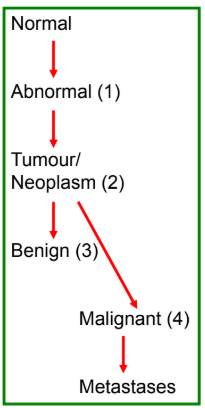
what are different primary tumors
basal cell carcinoma
origin = basal cells of epidermis
only locally invasive
melanoma
origin = melanocytes
aggressive invasion
what are some genetic causes of cancer
single nucleotide substitutions (SNPs)
chromosome arrangements (gains/loses, translocations)
integration of virus into chromosome
inappropriate DNA de(methylation) - epigenetic changes
why is cancer infrequent despite many daily mutations
cancer development requires several independent mutations in a single cell
many cancer cells have mutations in genes controlling growth, division, apoptosis
what are proto-oncogenes
gene regulatory proteins, promote
cell division
cell survival
can be involved in cell-cell signaling
produce signaling proteins
what are the 4 main ways to convert proto → oncogene
recombination with retroviral DNA
deletion or point mutation
gene amplification
chromosome rearrangement
where can changes occur in proto-oncogenes
protein coding region - hyperactive protein
regulatory regions - over expression
what is chronic myelogenous leukemia
non-lethal overproduction of white blood cells, these have an abnormality - Philadelphia chromosome
translocation between long arms of Chr 9 & Chr 22
fusion protein Bcr-Abl has hyperactive kinase activity
continues for several years between rapidly deteriorating
early stage = cells show translocation
late stage = several abnormalities, further mutations
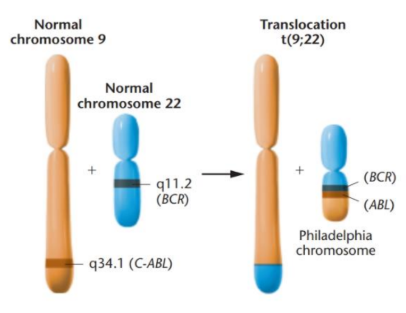
what is Burkitt’s lymphoma
B-cell (antibody-producing cells) malignancy
translocation = 8q11 to 14q32, or 2p11 to 22q11
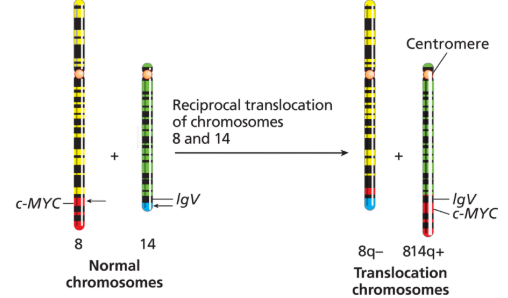
what is some info on Bcl-2 gene
located on chromosome 18q21 - translocation may convert it to an oncogene
inde
how does retinoblastoma form
Rb gene (-ve regulator of transcription)
patients with hereditary form inherit loss or mutation in one gene copy and are predisposed to developing cancer
sporadic event requires 2 independent mutations
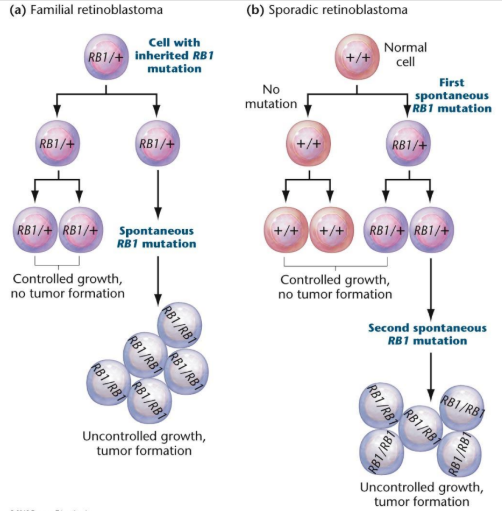
what is loss of heterozygosity in retinoblastoma
initial mutation = chromosomal deletion / point mutation
second copy of gene is lost/replaced by first defective gene
can result in loh – daughter cell is now homozygous for the mutation
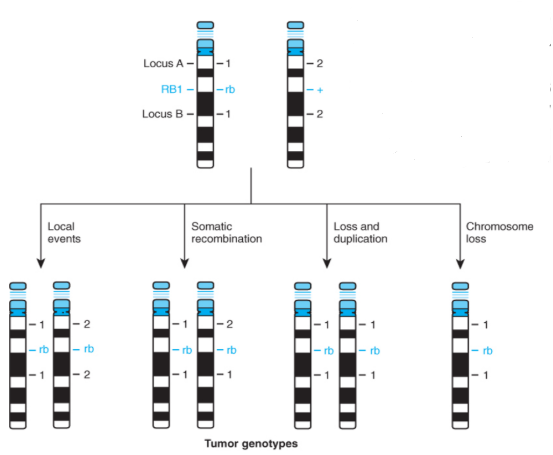
what is some info on the p53 gene
tumor suppressor gene with features of an oncogene
mutant protein binds to wildtype blocking function
dominant negative
normally low levels of p53 in cells but induced after DNA damage
functions as a control to recognize DNA damage
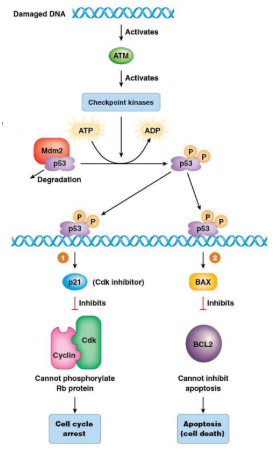
what are some common treatments for cancer
surgery
radiation - solid tumors
chemotherapy - targets rapidly dividing cells
targeted therapy - monoclonal antibodies, inhibitors, etc
what is evolution
encompasses all changes in the genetic composition of a population over time
not just adaptions but also genetic drift, gene flow and random mutation events
what is adaption
a subset of evolution, focusing especially on heritable, genetic changes that improve a populations ability to survive and reproduce
cannot happen without a mutation
what is the hierarchy of impacts for mutations
mutations that change protein sequence
protein changes that cause changes in the cell phenotype
phenotypes changes that change the fitness of organisms
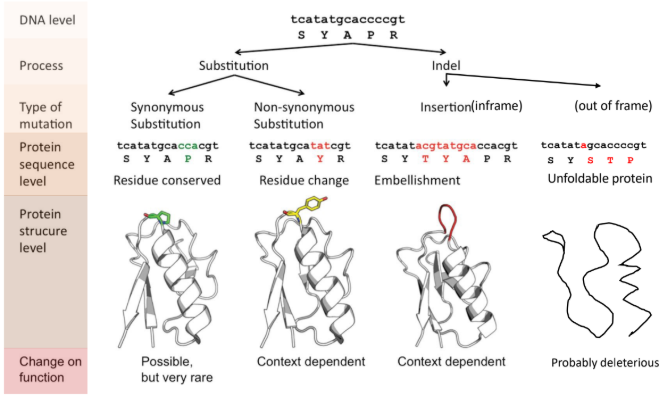
what are some assumptions for the Hardy-Weinberg Equilibrium
equal number of M/F
random mating
no selection
no migration
very large population size (no drift)
discrete generation
what is the Hardy-Weinberg equilibrium
A2 + 2Aa + a2 = 1
allows comparison of the genotype frequencies predicted under the HWE to the actual genotype frequencies
what are the 4 steps for using the HWE
count genotype frequencies from a sample of population
calculate allele frequencies
calculate HWE genotype frequencies
compare expected & observed
when might there be a deviation from HWE
natural selection could affect the individual & genotypes
population structure - e.g. 2 islands, one is homozygous for allele a, the other for allele A. If you summed the allele frequencies without know about the islands you would predict the existence of heterozygotes.
assortative mating - individual might breed with individuals of similar genotype
inbreeding between individuals affects genotype of population
why are chi-squares used
compares the observed genotype counts with those expected under HWE